‘Ocular demonstration’ or ‘tremendous treasure’?
Published in 20th-century / Contemporary History, Features, Issue 3 (May/June 2010), Volume 18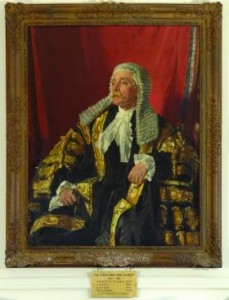
A 1922 painting of Lord Glenavy in traditional legal regalia by William Orpen. Glenavy was a giant in pre-Independence Irish law, serving as attorney general, chief justice and lord chancellor during the British administration. A staunch unionist, he helped Sir Edward Carson secure arms for the Ulster Volunteer Force in 1913, but had been cooperative with the Sinn Féin political order even before the establishment of the Free State. He positioned himself well enough that he was appointed to the Senate and was elected its chairman. (Private collection)
The controversy over judicial garb was indicative of two larger issues—judicial independence from the executive and Irish freedom from Britain. The former was important to unionists because they were relying on independent courts to protect their rights. In their opinion, judges could not be independent if their dress was determined by the executive. On the other hand, nationalists wanted the new judiciary to symbolise Ireland’s independence from Britain.
Championing their respective sides stood two of the most prominent figures in the legal profession. Hugh Kennedy, then attorney general of the Irish Free State and a nationalist, was a strong supporter of creating a new Irish judicial costume. His opponent was Lord Glenavy (James Campbell), who, under British rule, had held the highest judicial post in Ireland and was one of the most prominent unionists in the Irish Free State. The dispute between the two began on the judiciary committee, a group of legal experts who put forward a report that provided the basis for today’s Irish legal system. Glenavy chaired the committee, whose members had been selected by Kennedy.
Their disagreement, however, remained obscure to the general public because the committee met in private and there were no leaks to the media about its deliberations. The conflict between these two legal giants became public as legislation creating the new court system worked its way through the Oireachtas, where Kennedy and Glenavy were both prominent and vocal members. The debate, owing to the players involved and the interesting topic, grabbed the attention of politicians, legal experts and laymen alike during the two-year process of creating a new judiciary.
An ‘ocular demonstration’
Despite its importance, relatively few records or accounts of the judiciary committee’s deliberations survive today, but correspondence between Kennedy and District Justice Louis Walsh, a student acquaintance of his and a fellow committee member, has been preserved. The two shared similar political views and wrote to each other regularly, beginning in 1922. From these letters it is possible to piece together the nationalist position on the issue. Kennedy felt that adopting ‘a distinctly Irish costume will be an “ocular demonstration” to the man-in-the-street that our courts are really Irish ones’.
Nationalists feared that the judiciary in Ireland was suffering from an image problem. With Sinn Féin labelling the British-created judicial system as an entity of an alien power and putting forward the Dáil Courts as an alternative, the reputation of the courts of the British administration had been tarnished. The executive of the Irish Free State had its reasons for adopting the British-created system, but it was certainly confusing to the general public that the old court system was British one day and Irish the next. Kennedy recognised this problem and considered how laymen would view the new changes. He and other nationalists wanted to show that the Free State’s administration of justice was based on traditional Irish laws and customs.
Walsh agreed, believing that a simple costume ‘characteristic of Irish traditional art’ would ‘appeal very much to the national instinct’ and serve as ‘a perpetual reminder both to ourselves and to the world of our distinctive nationhood’. He was disappointed that ‘the other members of our committee could not see that far more propaganda would be used against our new courts on a question of this kind than in respect of far bigger issues’.
Kennedy ‘profoundly ignorant’ on brehon costume
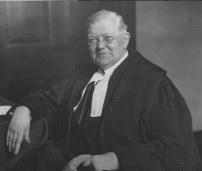
An official photo of Chief Justice Hugh Kennedy with, significantly, his wig in his hand and not on his head. Kennedy had been the Irish executive’s top legal expert even before the government was officially recognised by the British. He served as an adviser to the provisional government during negotiations over the Anglo-Irish Treaty, was its law officer and the Free State’s first attorney general. He would later be appointed the first chief justice of the Supreme Court, where he sat until his death in 1936. An ardent nationalist, his involvement in cultural organisations may explain his special interest in the costume debate. (UCD Archives)
Kennedy was not deterred by the deadlock of the judiciary committee on the costume issue, even though he did not know what an Irish costume should look like, admitting that he was ‘profoundly ignorant on the matter’. He assumed that it would be based on the attire worn by brehons centuries before, but was unsure as to what that was. To find an answer, he sought advice from Francis Biggar, a Belfast solicitor and antiquarian who was knowledgeable about the traditional garments. In correspondence with Kennedy and Walsh, Biggar provided information on how Irish judges dressed before the brehon legal system was suppressed by the British.
After learning more about brehon attire, Kennedy had clothing designers in Dublin prepare sketches for his review of what Irish judicial gowns should look like. He would not have the chance to develop these sketches, however, as he explained to Walsh on 5 November 1923 (5th letter):
‘The Bar is hostile to any change and, I fear, rather obstinately hostile. Some designs were recently made for me—quite privately—but the designer unfortunately showed them to a member of the Bar none too friendly, with the result that I had to scrap the thing and leave it so for the time being . . . It is a funny thing that the Bar clings to the wig with the greatest intensity, even to the extent of sending a lot of money out of the country to replace those burnt in the Four Courts.’
Kennedy did not press the matter further during the passage of the Courts of Justice Act, 1924 (Judiciary Bill), which created the new court system. The nationalists simply could not make any headway without the cooperation of the legal profession, whose ranks were filled with unionists unprepared to abandon old ways and suspicious of being told to do so by the new Dublin government.
Defending a ‘tremendous treasure’
While Kennedy’s efforts stalled, Glenavy used the clothing issue to defend the judiciary’s independence. In a speech to the Senate, he explained that an independent judiciary was ‘a tremendous treasure, a tremendous privilege, and [politicians] would be well advised both in the Dáil and in this house to guard most carefully against the slightest attempt to infringe upon it’. Senator Brown, the only other legal expert in the Senate besides Glenavy, elaborated on why an independent bench was so important. ‘There is no greater tyranny’, declared Brown, ‘than the tyranny of absolute democracy, and the only protection against that is the independence of the judges.’ Southern unionists were relying on the courts to protect their rights in the new democracy where they were the minority.
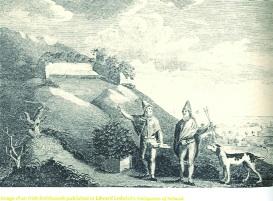
Irish breitheamh (brehons) as imagined in Edward Ledwich’s Antiquities of Ireland. Kennedy assumed that any new judicial costume would be based on the attire worn by brehons centuries before, but admitted that he was ‘profoundly ignorant on the matter’. (National Library of Ireland)
Glenavy held that the greatest infringements on judicial independence were the sections of the Judiciary Bill that established three rule-making authorities, one for each of the jurisdictional levels in the new court system. Each body would be responsible for making the rules (including judicial attire) for the courts for which it was established and would have judges from its respective jurisdictional level, as well as solicitors and barristers. The proposed legislation, however, added that the minister for home affairs would sit on each rule-making authority, an executive calling not initially recommended by the committee that made unionists nervous.
Glenavy was outraged that a member of the executive would help to craft the rules of another branch of government, saying: ‘I confess I am wholly at a loss to understand or account for [this] . . . it is the first time in the history of the British constitution that the judiciary have ever been exposed to such humiliation’. Glenavy wanted to remove the minister from the authorities, or at least have a way to check the executive’s influence.
Glenavy’s use of ridicule
To achieve his aim, Glenavy used the issue of costumes. Donal O’Sullivan, the clerk of the Senate, explained Glenavy’s actions:
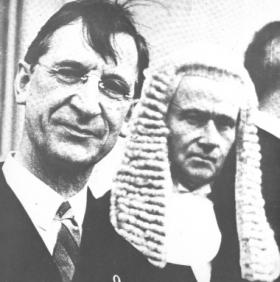
Éamon de Valera with Timothy Sullivan, who replaced Hugh Kennedy as chief justice after the latter’s death in 1936, at the time of the adoption of the 1937 constitution. It did away with many aspects of the original Free State constitution but the wigs stayed. (Irish Times)
‘Ridicule is always a potent weapon in Ireland, and the proposal about dress was a promising target for it. It was known that the attorney-general was determined if possible to abolish the traditional wig and gown . . . Lord Glenavy fixed upon this proposal as a butt for the display of his old forensic power of derision.’
In a humour-laced attack, Glenavy said that one minister
‘might prefer a kilt. His successor might be a sporting man, and he might prefer a jockey’s costume. The next successor might have clerical tendencies, and he might prefer to see the judges robed in clerical costume. Where is this thing to end? It is really childish.’
This example highlighted the problem of a minister, whose tenure was no longer than that of the cabinet he was part of, determining the rules of an institution that should be independent of politics.
Taking advantage of the secret nature of the judiciary committee’s proceedings, Glenavy claimed during a Senate debate that the committee, ‘with the exception of one, were unanimous (sic) in favour of the retention of the wig and gown’. At least two, of course (Kennedy and Walsh), had wanted to abolish the English costume, while the opinions of the other members still remain a matter of conjecture. Since the judiciary committee had legal experts with both unionist and nationalist sympathies, Glenavy knew that this false claim would bring him support.
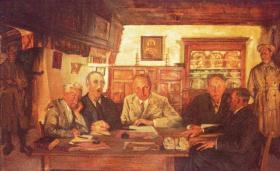
The informality of Seán Keating’s Republican Court 1921 is in marked contrast to the pomp and circumstance of the British system retained by the 1924 Courts of Justice Act. (Crawford Municipal Art Gallery)
Kennedy held his tongue on the floor of the Senate, but expressed his indignation to his friend Louis Walsh:
‘How he had the audacity to state such a tissue of falsehood, I do not know! . . . He stops at absolutely nothing to gain his own end. His advocacy is of the most thoroughly dishonest and disreputable character . . . He appears to be “out for my blood”, but he will have to “eat it in sand”.’
Walsh agreed, describing Glenavy as ‘a terrible old cod!’
Glenavy’s tactics may have been distasteful but they were effective. Although he failed to have the minister removed from the rule-making authorities, he came close, passing an amendment that all rules drawn up by the rule-making authorities should be approved by both houses of the Oireachtas before they took effect. This ensured that the Senate, which was the conservative cooling chamber of the new Dublin government and had significant unionist representation, could veto any rules put forward by the minister that would infringe upon judicial independence.
Conclusion
While replacing the English costumes might have been a better choice from a public relations perspective, the new court system was ultimately accepted by the Irish people anyway. Judges remained independent of the influence of the executive. Although the executive lost the battle on the costume issue, it had little difficulty in effectively adapting the judicial system that had presided over Ireland for centuries after the Judiciary Bill was passed.
The debate over judicial garb illustrates the ways in which nationalists and unionists disagreed over meanings of ‘independence’ and ‘freedom’ during the formative years of the Free State. But it also shows how the two sides, though seemingly at loggerheads, could find room for compromise and agreement. HI
James I. Dougherty received his BA in history from Carnegie Mellon University.
Further reading:
D. Foxton, Revolutionary lawyers: Sinn Féin and Crown Courts in Ireland and Britain, 1916–1923 (Dublin, 2008).
T. Garvin, 1922: The birth of Irish democracy (Dublin, 1996).
R. Keane, ‘The voice of the Gael: Chief Justice Kennedy and the emergence of the new Irish court system 1921–1936’, The Irish Jurist 31 (1996), 205–25.
D. O’Sullivan, The Irish Free State and its Senate (London, 1940).
















